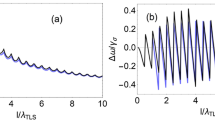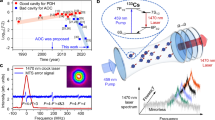Abstract
IN a cavity laser system, oscillation by stimulated emission occurs when the gain is sufficient to overcome the total loss in the cavity. Cavity loss not only determines the threshold condition of laser emission, it is also related to various properties of the laser output, such as the mode structure and the mode pulling effects. It is therefore important to measure accurately the cavity loss in a laser system. Previous workers have used the threshold electric input energy of the xenon flashtube as a means of evaluating the cavity loss for a pulsed ruby laser1–3. The non-linear behaviour of the xenon flashtube can cause measurement error, especially when the measurement was made over a wide range of temperature. There are two parts to this non-linear property: the total and peak radiant outputs in the pumping band are not linearly proportional to the electric input to the flashtube4, and the dependence on time of the radiant output varies with the electric input. However, if the time-varying flashtube radiant output power in the pumping band of the laser is directly measured, the total threshold radiant energy can be obtained by time integration of this pumping power up to the onset of the laser emission, assuming that the fluorescence decay time is long. This results in a loss measurement independent of the non-linearity of the flashtube.
This is a preview of subscription content, access via your institution
Access options
Subscribe to this journal
Receive 51 print issues and online access
$199.00 per year
only $3.90 per issue
Buy this article
- Purchase on SpringerLink
- Instant access to full article PDF
Prices may be subject to local taxes which are calculated during checkout
Similar content being viewed by others
References
Collins, R. J., and Nelson, D. F., Proc. Conf. Opt. Inst., London (1961).
Aagard, R. L., J. Opt. Soc. Amer., 53, 911 (1963).
Masters, J. I., Nature, 199, 442 (1963).
Nelson, D. F., and Remeika, J. P., J. App. Phys., 35, 522 (1964).
Aagard, R. L., and Dufault, R. A., App. Phys. Letters, 4, 102 (1964).
Nelson, D. F., and McCumber, D. E., Proc. Third Intern. Symp. Quantum Eectronicis, 1963 (to be published).
Aagard, R. L., J. App. Phys., 34, 3631 (1963).
McCumber, D. E., and Sturge, M. D., J. App. Phys., 34, 1682 (1963).
Author information
Authors and Affiliations
Rights and permissions
About this article
Cite this article
CHEN, D. Measurements of Cavity Loss in a Pulsed Ruby Laser. Nature 205, 271–272 (1965). https://doi.org/10.1038/205271a0
Issue date:
DOI: https://doi.org/10.1038/205271a0



